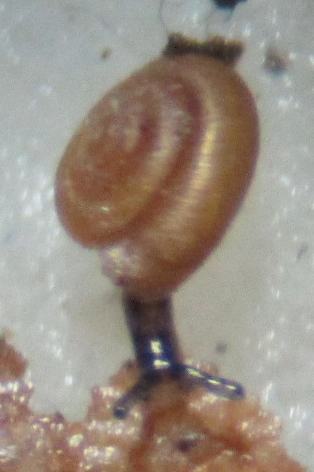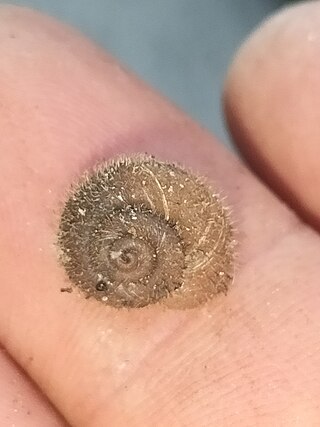
The Lord Howe flax snail or the Lord Howe placostylus, scientific name Placostylus bivaricosus, is a species of large air-breathing land snail, a terrestrial pulmonate gastropod mollusc in the family Bothriembryontidae.

Micronomus norfolkensis is a species of molossid bat, a family of flying mammals. The bat is endemic to Australia, where it occurs from southeastern Queensland to eastern New South Wales. They are the sole species of genus Micronomus and referred to by variations on east-coast free-tailed bat.
Allenoconcha retinaculum is a species of air-breathing land snail, a terrestrial pulmonate gastropod mollusc in the family Euconulidae.
Glacidorbis is a genus of minute freshwater snails with an operculum, aquatic gastropod molluscs or micromolluscs in the family Glacidorbidae.
Hemistomia beaumonti is a species of minute freshwater snails with an operculum, aquatic gastropod molluscs or micromolluscs in the family Tateidae. This species is endemic to Lord Howe Island, Australia.

Hemistomia is a genus of minute freshwater snails with an operculum, aquatic gastropod molluscs or micromolluscs in the family Tateidae.
Hemistomia flexicolumella is a species of minute freshwater snails with an operculum, aquatic gastropod molluscs or micromolluscs in the family Tateidae. This species is endemic to Australia.
Hemistomia gemma is a species of minute freshwater snail with an operculum, an aquatic gastropod mollusc or micromollusc in the family Tateidae. This species is endemic to Australia.
Hemistomia minutissima is a species of minute freshwater snail with an operculum, an aquatic gastropod mollusc or micromollusc in the family Tateidae. This species is endemic to Australia, where it is only known from the Erskine Valley, on the southern part of Lord Howe Island.
Hemistomia whiteleggei is a species of minute freshwater snail with an operculum, an aquatic gastropod mollusc or micromollusc in the family Tateidae. This species is endemic to Australia.

Monterissa gowerensis, also known as the Lord Howe microturban, is a species of minute cave snails with an operculum, gastropod mollusks in the family Hydrocenidae.

Helicarionidae is a family of air-breathing land snails or semi-slugs, terrestrial pulmonate gastropod mollusks in the superfamily Helicarionoidea.

Achatinellidae is a family of tropical air-breathing land snails, terrestrial pulmonate gastropod mollusks in the superfamily Pupilloidea.

Camaenidae is a family of air-breathing land snails, terrestrial pulmonate gastropod mollusks in the superfamily Helicoidea, the typical snails and their allies. This is one of the most diverse families in the clade Stylommatophora.

Pupinidae is a taxonomic family of land snails with an operculum, terrestrial gastropod mollusks in the superfamily Cyclophoroidea.

Punctidae, common name the "dot snails" or "pinhead snails", is a family of minute air-breathing land snails, terrestrial pulmonate gastropod mollusks or micromollusks in the informal group Sigmurethra.
Hemistomia shostakovichi is a species of minute freshwater snail with an operculum, an aquatic gastropod mollusc or micromollusc in the family Tateidae. This species is endemic to New Caledonia, where it is only known from one small seepage behind a micro-dam in a dry valley near Voh.

Tateidae is a family of very small and minute aquatic snails with an operculum, gastropod mollusks in the superfamily Truncatelloidea.

Tolgachloritis campbelli, the Chillagoe spiny snail, is a species of air-breathing land snail, terrestrial pulmonate gastropod mollusc in the family Camaenidae. The species was first described in 1938 as Mussonena campbelli by Tom Iredale, and was transferred to the genus, Tolgachloritis, in 2010 by John Stanisic and others.











